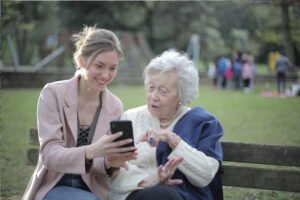
Helping Seniors Avoid Feelings of Isolation
While many places are reopening after record COVID diagnoses and deaths, seniors are still the highest risk group for complications. You and your loved ones may still be taking precautions to avoid infections. One of these precautions is being in public less and spending less time outside your home. Vaccine development can help senior adults return to preCOVID living, but not everyone is ready for that. If your loved one is still distancing, it is imperative that you help them battle feelings of isolation. To do this, you may have to get creative sometimes.
Outdoor Visits
If weather permits, masked outdoor visits may be one way to still visit with your loved ones. Wearing a mask is one way to still visit with loved ones. While the mask is not 100% effective, outdoor socially distanced visits may help your loved one get some sunshine and time with friends and family.
Frequent Phone Calls
Phone calls will never replace face-to-face visits, but calling your loved one daily might help them feel connected even when they cannot see you in person. Call your loved one daily or at least a few times a week. If you live with several people, try to schedule a time that everyone can talk or have each person call them often.
Facetime, Video Chats, and Zoom
While older adults aren’t always comfortable with technology, many of these features are available on their cell phones or computers. You can help them learn how to place and receive these calls from their friends and family. Invite them to a family dinner over Zoom. It’s not quite the same, but it can help your loved ones feel that you are with them a little more often. They can still see their friends.
Learn Something New
Your loved one might have taken up crocheting years ago and forgotten how. Encourage them to take up a craft or learn something new. YouTube and other video resources can be a great way to learn a new skill.
Encourage Them to Volunteer
One thing we forget is that volunteering isn’t always something that has to take place in person. Knitting hats for babies in the hospital, crocheting blankets for the homeless, or mailing cards to veterans does not require you to leave your home. Encourage your loved one to find an activity that gives back and can be done from home.
Final Thoughts
There are dozens of ways to stay in contact with your loved ones. These are just a few of the ways many people have helped their loved ones minimize the feelings of isolation. Seniors who feel isolated are more likely to become depressed, and elderly adults are a rising demographic in suicide cases. We want to avoid triggering depression and anxiety due to isolation. Talk to your loved ones and find out what would help them. Encourage them to learn, volunteer, and reach out to others during periods of social distancing and isolation.
